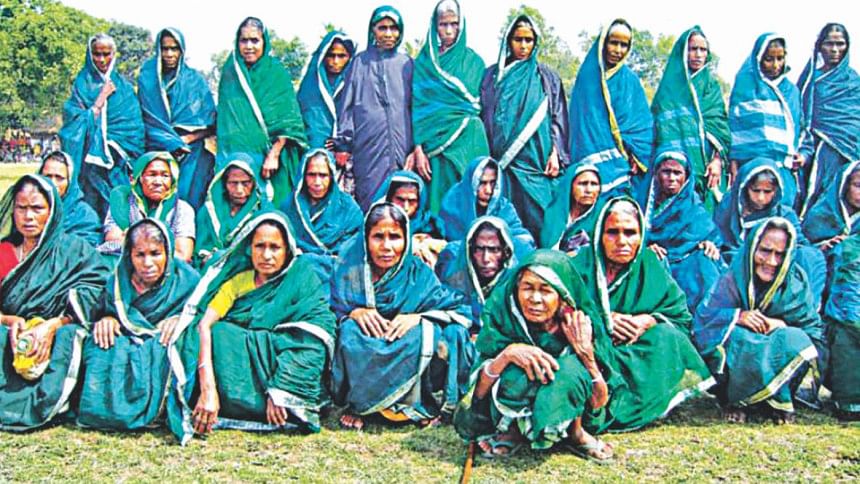Plight of the little-known 'tiger widows' of the Sundarbans

The number of tigers in the world's forests has dwindled to only 4,000 from 1 lakh over the last 100 years. Three sub-species of tiger out of total eight have already become extinct. The tiger is categorised as a critically endangered species due to deforestation, piracy and poaching worldwide.
The Sundarbans lies south of Bangladesh, and is the largest mangrove forest in the world. The government of Bangladesh issued a new notification on the expansion of sanctuary areas in different parts of Sundarbans after 22 years ("Sundarbans wildlife gets extended sanctuary", The Daily Star, September 23, 2018). Through this notification, another 178,260 hectares have been added to the existing sanctuary aggregate. That means over half the area of the Sundarbans in Bangladesh has sanctuary status. Out of the additional 178,000-odd hectares falling under sanctuary, 91,693 hectares have been added in Sundarbans East under the Sarankhola range; 38,339 hectares in the Sundarbans South under the Khulna range and a total of 48,216 hectares have been added in Sundarbans West, under the Satkhira range. The government has banned the collection of all types of forest resources from the sanctuary areas. It will help increase the biodiversity of the forest including wildlife and trees.
Close to 4 million people live in and around the Sundarbans, many of them are farmers or fisherfolk, and another 2 million people from the country's southern parts are directly or indirectly dependent on the mangrove forest. People dependent on the Sundarbans are poor. They face different problems in harvesting its resources. Poverty, exploitation and oppression are integral parts of their day-to-day life. The people most dependent on the forest are bawali (wood fellers), mawali (honey and wax collectors), and fishers.
Users of resources from the forest have to collect permission letters and pay government fees for entering the Sundarbans, but officials of the Forest Department (FD) often take an additional fixed amount as bribe from them, which is sometimes 10 to 20 times higher than the actual fee ("Political Commitments and Aspirations of Grassroots Coastal Communities: A Micro-Level Study in Bangladesh", American Journal of Rural Development, 2014, Vol. 2). Moreover, the majority of the Sundarbans' resource users have to pay a fixed amount of money regularly to dacoits; otherwise they are abducted or killed. They are also often the victims of dadandar (moneylenders).
Additionally, a number of male members of families dependent on the forest are killed by tigers. Killings of human beings by tigers in the Sundarbans lead to negative attitudes and retribution killings by local communities, which in turn have a substantial impact on the number of tigers in existence. There is still a lack of reliable micro level information about how many humans have been killed by tigers in the Sundarbans. However, the available literature cataloguing official government records shows that 1,396 human deaths were recorded over a span of 63 years, or an average of 22 human deaths per year. Local people suspect that this number is much higher than the number recorded. For instance, Nil Dumur of Shyamnagar upazila has been declared as a tiger-widow village—tiger widows (in Bengali: bagh bidhoba) are women whose husbands have been killed by tigers.
The Ministry of Environment, Forest and Climate Change of Bangladesh adopted the Compensation Policy for Casualties Caused by Wildlife. The amount of that compensation is too little for one family to live on, in the absence of their sole male earning-member. There are no other initiatives set up by the government or humanitarian agencies to rehabilitate tiger-widow families. Let's not forget that such people have constitutional rights. The right to social security through public assistance in case of poverty arising from death, illness or disablement, and other cases is mentioned in Section 15(d) under the "Provision of Basic Necessities" of Part II of the Constitution. The right to basic necessities for all citizens such as food, clothing, shelter, education and medical care and the right to work and employment, recreation and leisure are mentioned in Sections 15(a), 15(b) and 15(c) as well.
Tiger-widows are deprived of all human dignity, are discriminated against by their family and community, struggle to survive due to a profound degree of poverty, and are forced to live a life with a multitude of post-traumatic scars and deprivations, abuse, and exploitations. It is a matter of uncertain speculation whether the cry of the tiger-widows of Sundarbans will be heard by our policymakers. The number of tiger widows has increased silently in the nearby villages of the Sundarbans. From an eco-psychiatric perspective, this is a very serious concern that needs to be checked and balanced between two issues: conservation of biodiversity and the well-being of the forest-dependent population. The Sundarbans won't survive if the tigers don't survive. In parallel, we should protect both the tigers and human beings living in and around the Sundarbans.
Awareness should be created to eradicate social stigma against tiger widows. Rehabilitation initiatives like integrated farming, small-enterprise, interest-free loans and grants should be arranged for existing tiger widows by the government and NGOs. Scope of alternative income should be facilitated through special national budget allocation and local resource mobilisation for people who are dependent on the forest for their livelihoods, so that no one can enter the sanctuary areas for collecting resources that may damage the Sundarbans.
Mohammed Mamun Rashid is Programme Manager, Civic Engagement, Transparency International Bangladesh (TIB).
E-mail: [email protected]





Comments